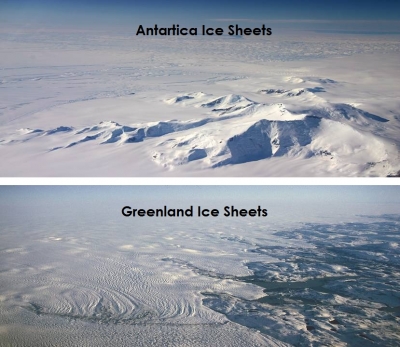
|
In today’s world, the ice sheets of Antarctica and Greenland. An ice sheet is a continuous mass of ice covering more than 50,000 km2. The ice sheet in Antarctica covers 14 million km2. It is 1.6 to 6.4 km thick and holds 30 million km2 of ice. The Greenland ice sheet covers about 1.7 million km2. |
The Antarctic ice sheet is the largest block of ice on Earth. It covers more than 14 million square kilometers (5.4 million square miles) and contains about 30 million cubic kilometers (7.2 million cubic miles) of water.
The Antarctic ice sheet is about 2 kilometers (1.2 miles) thick. If it melted, sea level would rise by about 60 meters (200 feet).
The Greenland ice sheet is much smaller than the Antarctic Ice sheet, only about 1.7 million square kilometers (656,000 square miles). It is still the second-largest body of ice on the planet.
The Greenland ice sheet interacts much more dynamically with the ocean than the Antarctic ice sheet. The annual snow accumulation rate is more than double that of Antarctica. Glacial melt happens across about half of the Greenland ice sheet, whereas it is much more isolated on the far western part of Antarctica. Greenland’s ice shelves break up much faster than those surrounding Antarctica.
Both the Antarctic and Greenland ice sheets have caused the land under them to sink. Eastern Antarctica is about 2.5 kilometers (1.6 miles) below sea level because of the colossal weight of the ice sheet above it.
Credit: National Geographic
Picture Credit : Google




